文章
Dummer. ゛☀
2017年07月02日

Another name for Gentiana
Gentiana, also known as gall grass, grass, gentian, gentian, gentian.
The growth habit of Gentiana
Comparison of temperature Liangyi point gentian love love climate, humid environment, soil is acidic soil.
Ornamental value of gentian
Gentian ornamental value is still there. Some of them are quite ornamental, such as magnificent gentian, fringed gentian and so on. The flowers are gorgeous and beautiful.
Propagation method of Gentiana
In the breeding of Gentiana, the majority of people are sowing and breeding, requiring light and humidity better.
Next is the root propagation, in the autumn time, dig out the root of Gentiana, cut after planting.
In addition, it can also be used for cutting.
Morphological characteristics
30-60 cm tall. Rhizomes prostrate or erect, shortening or 5 cm long, stout, slightly fleshy, with numerous fibrous roots.
Flowers solitary, erect, yellow green or purple red, hollow, suborbicular, with edges, edge papillate, thin and smooth. The lower branch leaves membranous, pale purple red, scaly, 4-6 mm long, apex separation, even below the central tubular synthetic clasping; in the middle and upper leaves subleathery, sessile, ovate or ovate lanceolate to linear lanceolate, 2-7 cm long, 2-3 cm wide, sometimes only about 0.4 cm wide, more to the upper stem leaves smaller, apex acute, base cordate or rounded, margin slightly revolute, rough, above the dense fine papillae, the smooth, veins 3-5, in the above is not obvious in the following processes, rough. Flowers numerous, fascicled top branches and leaf axils; no pedicel; each flower with 2 bracts, bracts and sepals lanceolate or linear lanceolate, subequal, 2-2.5 cm long; calyx tube obconical or wide cylindrical tube shaped, 10-12 mm long, outer lobes often anti or spreading, irregular shape or linear lanceolate, 8-10 mm long, apex acute, rough edge, midrib abaxially, curved short truncate; corolla blue purple, sometimes with many yellow green spots, tubular campanulate, 4-5 cm long, lobes ovate or ovate, 7-9 mm long, apex with the tip of the tail, entire, fold deviation narrowly triangular, 3-4 mm long, apex acute or 2 lobed; stamens attached to middle crown cylinder, neat, filaments subulate, 9-12 mm long, anthers narrowly oblong, 3.5-4.5 mm long; ovary narrowly elliptic or lanceolate, 1.2-1.4 cm long, tapering or ends Base obtuse, stipe thick, 0.9-1.1 cm long, style short, stigma long 3-4 mm, stigma 2 lobed, lobes rounded.
Capsule enclosed, broadly elliptic, 2-2.5 cm long, obtuse at both ends, long to 1.5 cm, seed brown, shiny, linear or fusiform, 1.8-2.5 mm long, with coarsely reticulate surfaces, with broad wings at both ends.
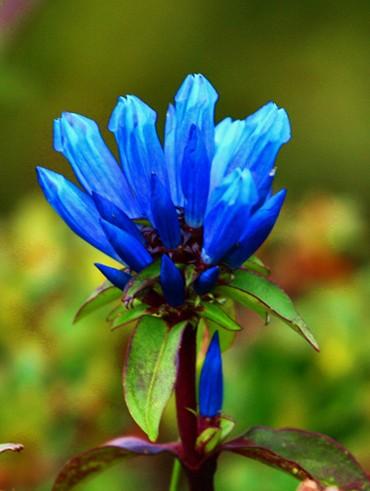
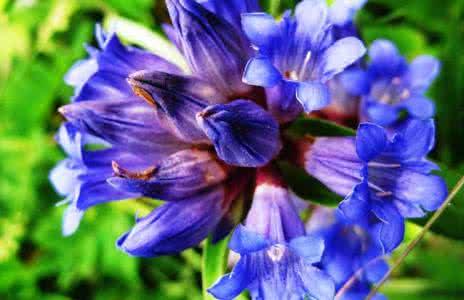
Gentiana, also known as gall grass, grass, gentian, gentian, gentian.
The growth habit of Gentiana
Comparison of temperature Liangyi point gentian love love climate, humid environment, soil is acidic soil.
Ornamental value of gentian
Gentian ornamental value is still there. Some of them are quite ornamental, such as magnificent gentian, fringed gentian and so on. The flowers are gorgeous and beautiful.
Propagation method of Gentiana
In the breeding of Gentiana, the majority of people are sowing and breeding, requiring light and humidity better.
Next is the root propagation, in the autumn time, dig out the root of Gentiana, cut after planting.
In addition, it can also be used for cutting.
Morphological characteristics
30-60 cm tall. Rhizomes prostrate or erect, shortening or 5 cm long, stout, slightly fleshy, with numerous fibrous roots.
Flowers solitary, erect, yellow green or purple red, hollow, suborbicular, with edges, edge papillate, thin and smooth. The lower branch leaves membranous, pale purple red, scaly, 4-6 mm long, apex separation, even below the central tubular synthetic clasping; in the middle and upper leaves subleathery, sessile, ovate or ovate lanceolate to linear lanceolate, 2-7 cm long, 2-3 cm wide, sometimes only about 0.4 cm wide, more to the upper stem leaves smaller, apex acute, base cordate or rounded, margin slightly revolute, rough, above the dense fine papillae, the smooth, veins 3-5, in the above is not obvious in the following processes, rough. Flowers numerous, fascicled top branches and leaf axils; no pedicel; each flower with 2 bracts, bracts and sepals lanceolate or linear lanceolate, subequal, 2-2.5 cm long; calyx tube obconical or wide cylindrical tube shaped, 10-12 mm long, outer lobes often anti or spreading, irregular shape or linear lanceolate, 8-10 mm long, apex acute, rough edge, midrib abaxially, curved short truncate; corolla blue purple, sometimes with many yellow green spots, tubular campanulate, 4-5 cm long, lobes ovate or ovate, 7-9 mm long, apex with the tip of the tail, entire, fold deviation narrowly triangular, 3-4 mm long, apex acute or 2 lobed; stamens attached to middle crown cylinder, neat, filaments subulate, 9-12 mm long, anthers narrowly oblong, 3.5-4.5 mm long; ovary narrowly elliptic or lanceolate, 1.2-1.4 cm long, tapering or ends Base obtuse, stipe thick, 0.9-1.1 cm long, style short, stigma long 3-4 mm, stigma 2 lobed, lobes rounded.
Capsule enclosed, broadly elliptic, 2-2.5 cm long, obtuse at both ends, long to 1.5 cm, seed brown, shiny, linear or fusiform, 1.8-2.5 mm long, with coarsely reticulate surfaces, with broad wings at both ends.


0
0
文章
Dummer. ゛☀
2017年07月02日

The growth habit of
Jerusalem artichoke is a relatively hardy and drought tolerant plant that can withstand low temperatures. When breeding, pay attention to adequate lighting. When choosing soil, it is not high, but acid soil, swamp and saline alkali soil are not suitable for planting.
The comprehensive utilization value of Jerusalem artichoke
Jerusalem artichoke value is relatively high, it is edible, stem and leaf can be used as feed, the tubers can be processed into vegetables or pickles, can also be used as inulin and alcohol, and Jerusalem artichoke or a valuable industrial raw materials.
Morphological characteristics
Jerusalem artichoke is a perennial herb, 1-3 m tall, with a mass of underground stems and fibrous roots. Stems erect, branched, white, shortly strigose or setose. Usually, the leaf petiole, but the upper part of Ye Husheng; the lower leaves ovate or ovate elliptic, with a long handle, 10-16 cm long, 3-6 cm wide, base broadly cuneate or rounded, sometimes slightly cordate, apex tapering acuminate, margin coarsely serrate, from base three above is below the white veined, stubby wool, puberulent, with short bristles veins, upper leaves oblong to broadly lanceolate, base attenuate, decurrent into short winged, apex acuminate, short tail.
The capitulum is large, few or many, was born in a single branch end, there are 1-2 linear lanceolate bracts, erect, 2-5 cm in diameter, involucral bracts multilayer, lanceolate, 14-17 mm long, 2-3 mm wide.


Jerusalem artichoke is a relatively hardy and drought tolerant plant that can withstand low temperatures. When breeding, pay attention to adequate lighting. When choosing soil, it is not high, but acid soil, swamp and saline alkali soil are not suitable for planting.
The comprehensive utilization value of Jerusalem artichoke
Jerusalem artichoke value is relatively high, it is edible, stem and leaf can be used as feed, the tubers can be processed into vegetables or pickles, can also be used as inulin and alcohol, and Jerusalem artichoke or a valuable industrial raw materials.
Morphological characteristics
Jerusalem artichoke is a perennial herb, 1-3 m tall, with a mass of underground stems and fibrous roots. Stems erect, branched, white, shortly strigose or setose. Usually, the leaf petiole, but the upper part of Ye Husheng; the lower leaves ovate or ovate elliptic, with a long handle, 10-16 cm long, 3-6 cm wide, base broadly cuneate or rounded, sometimes slightly cordate, apex tapering acuminate, margin coarsely serrate, from base three above is below the white veined, stubby wool, puberulent, with short bristles veins, upper leaves oblong to broadly lanceolate, base attenuate, decurrent into short winged, apex acuminate, short tail.
The capitulum is large, few or many, was born in a single branch end, there are 1-2 linear lanceolate bracts, erect, 2-5 cm in diameter, involucral bracts multilayer, lanceolate, 14-17 mm long, 2-3 mm wide.


1
1
文章
Dummer. ゛☀
2017年07月02日

Butterbur require moist air. When choosing the soil, you usually choose loose, fertile soil, and be careful not to be too dry. Keep the proper temperature when cooking, but not too high in summer, take care not to exceed 35 degrees. When planting, it needs to be fertilized in advance to make it grow better.
Method for propagating bee hopper
Butterbur breeding, usually with rhizomes multiply, breeding time, general is selected in the late autumn and early winter. Choose vegetables with relatively strong roots, and be careful not to choose pests or diseases.
Morphological characteristics
A perennial herb. With high 10-20cm, hollow, female plant stem fruit was as high as 60cm, white hair or silk like cotton wool. Rhizome stocky, sprouting branches around the cross walk, how much is white hair or wool. Leaves basal, long petiolate, up to 23cm, at the surface of wool, leaf blade cordate or reniform, to spend after, 2.8-8.6cm long, 12-15cm wide, the gray green, with arachnoid tomentum, margin biserrate. Flower stems from the root extract, dioecious; stem alternate scaly bracts, with flat heads are arranged into veins; female flowers corymbose; corolla filaments, white; involucral bracts 2, subequal, oblong, apex obtuse; corolla tube shaped male or bisexual, 5 teeth, teeth lanceolate, acute, yellowish white, sterile. Achenes smooth linear, glabrous, white crested.


Method for propagating bee hopper
Butterbur breeding, usually with rhizomes multiply, breeding time, general is selected in the late autumn and early winter. Choose vegetables with relatively strong roots, and be careful not to choose pests or diseases.
Morphological characteristics
A perennial herb. With high 10-20cm, hollow, female plant stem fruit was as high as 60cm, white hair or silk like cotton wool. Rhizome stocky, sprouting branches around the cross walk, how much is white hair or wool. Leaves basal, long petiolate, up to 23cm, at the surface of wool, leaf blade cordate or reniform, to spend after, 2.8-8.6cm long, 12-15cm wide, the gray green, with arachnoid tomentum, margin biserrate. Flower stems from the root extract, dioecious; stem alternate scaly bracts, with flat heads are arranged into veins; female flowers corymbose; corolla filaments, white; involucral bracts 2, subequal, oblong, apex obtuse; corolla tube shaped male or bisexual, 5 teeth, teeth lanceolate, acute, yellowish white, sterile. Achenes smooth linear, glabrous, white crested.


0
0
文章
Dummer. ゛☀
2017年07月02日

Growth habit of Eurasian mustard
Eurasian mustard is a kind of plant adaptability is strong, when breeding blue incense mustard, usually need full sun environment, appropriate shading in summer time. The soil is generally wet and well drained.
Eurasian mustard breeding is generally self reproduction, generally second years after planting to flower.
The Eurasian mustard flower smells like lilacs.
The flowers and culture of the blue mustard
clustered on the branches, so called wild Phlox, but less than a petal petal phlox.
Morphological characteristics of the mustard blue
Is a perennial or biennial shorter growth period of plants. The vertical height of about 60, much branched, to 90 cm, usually less than 120 cm. 30 ~ 60 cm width. Leaf margin serrate, elliptic to, dark green. Flowers are white, pale purple or purple flower diameter 1.2 ~ 2.4 cm, 4 petals, racemes, and is very similar. Because the flowers and Phlox are similar, are clustered on a long handle, so it is often called the "wild Phlox", but the blue petals less than sweet mustard phlox tablets. Flowers have a clove like scent, especially in the evening, with a strong fragrance.
Per cluster of flowers than , flower shape and color consistency. The seed ratio of small, per kilogram of seed is about 540 thousand grains, and usually less than 400 thousand grains of .


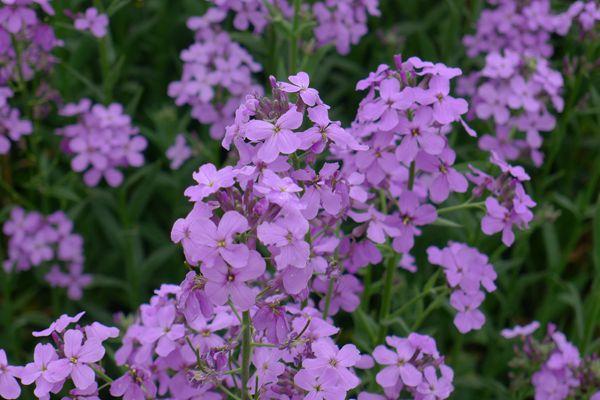
Eurasian mustard is a kind of plant adaptability is strong, when breeding blue incense mustard, usually need full sun environment, appropriate shading in summer time. The soil is generally wet and well drained.
Eurasian mustard breeding is generally self reproduction, generally second years after planting to flower.
The Eurasian mustard flower smells like lilacs.
The flowers and culture of the blue mustard
clustered on the branches, so called wild Phlox, but less than a petal petal phlox.
Morphological characteristics of the mustard blue
Is a perennial or biennial shorter growth period of plants. The vertical height of about 60, much branched, to 90 cm, usually less than 120 cm. 30 ~ 60 cm width. Leaf margin serrate, elliptic to, dark green. Flowers are white, pale purple or purple flower diameter 1.2 ~ 2.4 cm, 4 petals, racemes, and is very similar. Because the flowers and Phlox are similar, are clustered on a long handle, so it is often called the "wild Phlox", but the blue petals less than sweet mustard phlox tablets. Flowers have a clove like scent, especially in the evening, with a strong fragrance.
Per cluster of flowers than , flower shape and color consistency. The seed ratio of small, per kilogram of seed is about 540 thousand grains, and usually less than 400 thousand grains of .



0
0
文章
Dummer. ゛☀
2017年07月01日

The name of money wood is also called "cloud wood" and "Golden Jade".
Growth habit of
They like light, and they prefer warm and dry. They are tolerant of drought, but they are afraid of cold and basin soil. When breeding money to keep the wood light enough to avoid the overgrowth and light leaf color phenomenon.
Summer should pay attention to reduce watering, winter should pay attention to heat preservation. In the cultivation should pay attention to dry, not pouring, pouring on the water.
The name of money wood
The name "money tree" gets its name because of its leaf shape. The leaves of money wood are round and thick. They look like copper coins.
cultivation techniques
temperature
Growth temperature is 20~32 degrees, whether potted or ground planted, require annual average temperature change is small, productive cultivation is best in controlled temperature greenhouse.
Every summer, when the temperature reached 35 degrees above, poor plant growth, through the network and with black shading to the surrounding environment and other measures to cool the water, creating a space for its suitability and environmental temperature relatively dry. The best winter can be maintained at above 10 degrees in temperature, if the temperature is below 5 DEG C, easily lead to plant frostbite and seriously endanger its survival. The late autumn and early winter, when temperatures drop to below 8 DEG C, should promptly move it in a well lit room, in the winter, the temperature should be maintained at between 8 to 10 DEG C, it is safe and reliable.
Illumination
Money, wood, light and strong resistance to negative, should create a better sunshine, but also a certain degree of shade environment. It avoid direct sunlight, especially the spring and early summer should avoid sun exposure after a long period of rain and summer noon before and after 5~6 hours without shelter stopped light baking, otherwise easily lead to young leaves new pumping burns.
The production of cultivation, from late spring to Mid Autumn Festival, should put it in the shade 50 ~ 70% shade, but not too dark, or will the new pumping leaves slender, yellow leaf absence leads, lobular spacing sparse, which affects the plant compact and beautiful. Potted plants that move to the shed in winter should be supplemented with light. Basin soil moisture retention, the plant can remain disease-free for many years. Don't smoke outside the new pinnate fronds are not obvious phototaxis, good plant type.
Water content
In order to conserve potted wood, we should strive to create a moist and dry environment. In productive cultivation, plants in greenhouses should be treated with water once a day when the temperature is above 33 degrees celsius. Because the plant has strong resistance to drought, should be to keep the soil moist dry as well, but occasionally watering excess water, does not cause root rot.
Winter should pay attention to the leaves and the surrounding environment water jet, so that the relative humidity of air access to more than 50%. After the Mid Autumn Festival to reduce water, or water instead of watering, to the new leaves yesterday, the safe winter. In addition, in winter, special attention should be paid to the basin soil can not be too humid, with partial dry as good, otherwise, in low temperature conditions, the basin soil too wet, more likely to lead to decay of plant roots, or even whole plant death.
soil
Because of the special climate condition of the wood origin, the strong drought resistance has been formed. Therefore, the basic requirement of the culture medium is good permeability. The basic requirement of the culture medium is good permeability. Use of peat and sand substrates or washed coal and a small amount of garden soil mixed, and the pH adjusted to 6 ~ 6.5, is slightly acidic condition. Because of its huge tubers, well-developed roots and long pinnate leaves, the growth season should be observed in time to determine whether or not to change pots and soil. All the time, the cultivated substrate is well permeable, so as to create a good root environment for air filtration and water filtration. During the rainy season, it is necessary to check frequently and find that there is water accumulation in the basin.
fertilizer
Wood is money like fertilizer, except in culture medium should be added before retting cake or multiple slow-release compound fertilizer, the growing season can be 2 to 3 times per month watering 2% urea and 0.1% potassium dihydrogen phosphate mixture, can also be watering balance fertilizer 20-10-20 (20-20-20), the concentration of 200 ~ 250PPM with the use of calcium nitrate. When the temperature drops below 15 degrees Celsius, all forms of topdressing should be stopped, so as not to cause damage to the roots under low temperature.



Growth habit of
They like light, and they prefer warm and dry. They are tolerant of drought, but they are afraid of cold and basin soil. When breeding money to keep the wood light enough to avoid the overgrowth and light leaf color phenomenon.
Summer should pay attention to reduce watering, winter should pay attention to heat preservation. In the cultivation should pay attention to dry, not pouring, pouring on the water.
The name of money wood
The name "money tree" gets its name because of its leaf shape. The leaves of money wood are round and thick. They look like copper coins.
cultivation techniques
temperature
Growth temperature is 20~32 degrees, whether potted or ground planted, require annual average temperature change is small, productive cultivation is best in controlled temperature greenhouse.
Every summer, when the temperature reached 35 degrees above, poor plant growth, through the network and with black shading to the surrounding environment and other measures to cool the water, creating a space for its suitability and environmental temperature relatively dry. The best winter can be maintained at above 10 degrees in temperature, if the temperature is below 5 DEG C, easily lead to plant frostbite and seriously endanger its survival. The late autumn and early winter, when temperatures drop to below 8 DEG C, should promptly move it in a well lit room, in the winter, the temperature should be maintained at between 8 to 10 DEG C, it is safe and reliable.
Illumination
Money, wood, light and strong resistance to negative, should create a better sunshine, but also a certain degree of shade environment. It avoid direct sunlight, especially the spring and early summer should avoid sun exposure after a long period of rain and summer noon before and after 5~6 hours without shelter stopped light baking, otherwise easily lead to young leaves new pumping burns.
The production of cultivation, from late spring to Mid Autumn Festival, should put it in the shade 50 ~ 70% shade, but not too dark, or will the new pumping leaves slender, yellow leaf absence leads, lobular spacing sparse, which affects the plant compact and beautiful. Potted plants that move to the shed in winter should be supplemented with light. Basin soil moisture retention, the plant can remain disease-free for many years. Don't smoke outside the new pinnate fronds are not obvious phototaxis, good plant type.
Water content
In order to conserve potted wood, we should strive to create a moist and dry environment. In productive cultivation, plants in greenhouses should be treated with water once a day when the temperature is above 33 degrees celsius. Because the plant has strong resistance to drought, should be to keep the soil moist dry as well, but occasionally watering excess water, does not cause root rot.
Winter should pay attention to the leaves and the surrounding environment water jet, so that the relative humidity of air access to more than 50%. After the Mid Autumn Festival to reduce water, or water instead of watering, to the new leaves yesterday, the safe winter. In addition, in winter, special attention should be paid to the basin soil can not be too humid, with partial dry as good, otherwise, in low temperature conditions, the basin soil too wet, more likely to lead to decay of plant roots, or even whole plant death.
soil
Because of the special climate condition of the wood origin, the strong drought resistance has been formed. Therefore, the basic requirement of the culture medium is good permeability. The basic requirement of the culture medium is good permeability. Use of peat and sand substrates or washed coal and a small amount of garden soil mixed, and the pH adjusted to 6 ~ 6.5, is slightly acidic condition. Because of its huge tubers, well-developed roots and long pinnate leaves, the growth season should be observed in time to determine whether or not to change pots and soil. All the time, the cultivated substrate is well permeable, so as to create a good root environment for air filtration and water filtration. During the rainy season, it is necessary to check frequently and find that there is water accumulation in the basin.
fertilizer
Wood is money like fertilizer, except in culture medium should be added before retting cake or multiple slow-release compound fertilizer, the growing season can be 2 to 3 times per month watering 2% urea and 0.1% potassium dihydrogen phosphate mixture, can also be watering balance fertilizer 20-10-20 (20-20-20), the concentration of 200 ~ 250PPM with the use of calcium nitrate. When the temperature drops below 15 degrees Celsius, all forms of topdressing should be stopped, so as not to cause damage to the roots under low temperature.



2
1
求助
khaki83
2017年07月01日

I've just repotted my avocado plant, do I now need to cover the pip with soil? thanks :)
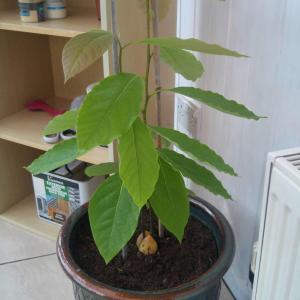

2
0
khaki83:@meriunkat I do too :) my first Avocado tree!
khaki83:@sunnyzou thank you :)
sunnyzou:I saw someone covered the pip.
meriunkat:I love avocados 😁
文章
Dummer. ゛☀
2017年07月01日

Another name for anemone
Autumn peony, also known as wild cotton, blowing peony, soil peony, Tyumen chrysanthemum, your boat chrysanthemum.
The growth habit of Anemone
Anemone is native to the central part of the country. It enjoys warm, humid and sunny conditions. It is relatively cold, but it is afraid of high temperature. It should be properly protected during summer. Autumn peony can stand half shade, but not too dry in breeding.
Breeding autumn peonies requires loose, fertile sandy soil.
The main value of Anemone
Autumn Peony Ornamental value is very high, it is more beautiful flower color, pink or white, very chic, suitable for the cultivation of ornamental potted flower border layout, or.
Morphological character
Herbs perennial, plants high (20-) 30-120 cm. Rhizome oblique or vertical, ca. 10 cm, coarse (2-) 4-7 mm.
Basal leaves 3-5, with a long handle, three leaves, sometimes 1-2 or all is simple; the central lobular with a long handle (1-6.5 cm long), leaflets ovate or broadly ovate, 4-11 cm long, 3-10 cm wide, apex acute or acuminate, base rounded or cordate, undivided or 3-5 two lobed, margin serrate, sparsely strigose; small lateral leaflets; petioles 3-36 cm long, sparsely pubescent, basally with short sheath.
Scape erect, sparsely puberulent; cymes 2-3 to have more branches, flowers, occasionally unbranched, only 3 flowered; bracts 3, shank (0.5-6 cm long), slightly unequal, three leaves, like basal leaves; peduncle 3-10 cm, densely or sparsely pilose; sepals 20 red, purple or violet, obovate, 2-3 cm long, 1.3-2 cm wide, short villi outside; stamens ca. as sepals length 1/4, anthers yellow, oval shaped silk filaments; carpels ca. 400, was born in the spherical torus, ca. 1.5 mm. Ovary with a long handle, short villi, stigma rectangle.
Aggregate fruit globose, ca. 1.5 cm in diam., achene ca. 3.5 mm, slender, densely woolly. Flowers bloom from July to October.



Autumn peony, also known as wild cotton, blowing peony, soil peony, Tyumen chrysanthemum, your boat chrysanthemum.
The growth habit of Anemone
Anemone is native to the central part of the country. It enjoys warm, humid and sunny conditions. It is relatively cold, but it is afraid of high temperature. It should be properly protected during summer. Autumn peony can stand half shade, but not too dry in breeding.
Breeding autumn peonies requires loose, fertile sandy soil.
The main value of Anemone
Autumn Peony Ornamental value is very high, it is more beautiful flower color, pink or white, very chic, suitable for the cultivation of ornamental potted flower border layout, or.
Morphological character
Herbs perennial, plants high (20-) 30-120 cm. Rhizome oblique or vertical, ca. 10 cm, coarse (2-) 4-7 mm.
Basal leaves 3-5, with a long handle, three leaves, sometimes 1-2 or all is simple; the central lobular with a long handle (1-6.5 cm long), leaflets ovate or broadly ovate, 4-11 cm long, 3-10 cm wide, apex acute or acuminate, base rounded or cordate, undivided or 3-5 two lobed, margin serrate, sparsely strigose; small lateral leaflets; petioles 3-36 cm long, sparsely pubescent, basally with short sheath.
Scape erect, sparsely puberulent; cymes 2-3 to have more branches, flowers, occasionally unbranched, only 3 flowered; bracts 3, shank (0.5-6 cm long), slightly unequal, three leaves, like basal leaves; peduncle 3-10 cm, densely or sparsely pilose; sepals 20 red, purple or violet, obovate, 2-3 cm long, 1.3-2 cm wide, short villi outside; stamens ca. as sepals length 1/4, anthers yellow, oval shaped silk filaments; carpels ca. 400, was born in the spherical torus, ca. 1.5 mm. Ovary with a long handle, short villi, stigma rectangle.
Aggregate fruit globose, ca. 1.5 cm in diam., achene ca. 3.5 mm, slender, densely woolly. Flowers bloom from July to October.



0
0
文章
Dummer. ゛☀
2017年06月30日

The growth habit of Huang Zhonghua
Huang Zhonghua, general is more like a plant light fear of floods, it love light, generally requires full sun or partial sunshine, choose when to choose soil well drained and rich in organic matter, it is best to add a little fertilizer in soil, good for flowering. Water is generally sufficient, because of the drought is disadvantageous to yellow sikkmensis terms.
The ornamental function of Huang Zhonghua
When Huang Zhonghua blossoms, it is always golden, golden and yellow. It is very bright and bright. It can be used for planting or planting trees. It can also be potted and preserved, and it can make a good decorative effect.
Morphological character
Perennial herb. Stem base stout, with persistent scales on top, scales ovate, ca. 3 mm, ca. 1 mm wide. The number of stems and, ascending, 7-12 cm long, unbranched or short branched, densely gray white villous development. Ye Husheng, the only spend 4 or 5 leaves were gathered from verticillate shape, lower stem to increase gradually, more dense, subsessile; leaf blade elliptic or ovate, 5-14 mm long, 3-8 mm wide, two sharp, edges reflexed, entire, two students to carry out gray white pilose or glabrous. Flowers solitary in the top of the stem, pedicels 1-2 cm long, glabrous or sparsely pubescent; calyx tube shaped, round bottom, fruit enlargement, tube length and width nearly equal, 8-10 mm, glabrous, lobes triangular, both the length and width of about 3 mm, in sparsely pilose; corolla yellow or pale yellow, 2.5-2.7 cm long. Outside glabrous, inside throat densely white pilose, lobes obovate oblong or obovate elliptic, 1.4-1.6 cm long, 5-7 mm wide, apex usually few rusty pilose; calyx tube and ovary at about equal length, style beyond the corolla. Florescence 7-8 months. [1]
Leaves of this species elliptic or ovoid, 5-14 mm long, 3-8 mm wide, both ends acute, entire; corolla yellow or pale yellow, lobes longer than tube, distinct from similar species. Type specimens were collected from Yunnan (Lijiang). This species contains two variants.



Huang Zhonghua, general is more like a plant light fear of floods, it love light, generally requires full sun or partial sunshine, choose when to choose soil well drained and rich in organic matter, it is best to add a little fertilizer in soil, good for flowering. Water is generally sufficient, because of the drought is disadvantageous to yellow sikkmensis terms.
The ornamental function of Huang Zhonghua
When Huang Zhonghua blossoms, it is always golden, golden and yellow. It is very bright and bright. It can be used for planting or planting trees. It can also be potted and preserved, and it can make a good decorative effect.
Morphological character
Perennial herb. Stem base stout, with persistent scales on top, scales ovate, ca. 3 mm, ca. 1 mm wide. The number of stems and, ascending, 7-12 cm long, unbranched or short branched, densely gray white villous development. Ye Husheng, the only spend 4 or 5 leaves were gathered from verticillate shape, lower stem to increase gradually, more dense, subsessile; leaf blade elliptic or ovate, 5-14 mm long, 3-8 mm wide, two sharp, edges reflexed, entire, two students to carry out gray white pilose or glabrous. Flowers solitary in the top of the stem, pedicels 1-2 cm long, glabrous or sparsely pubescent; calyx tube shaped, round bottom, fruit enlargement, tube length and width nearly equal, 8-10 mm, glabrous, lobes triangular, both the length and width of about 3 mm, in sparsely pilose; corolla yellow or pale yellow, 2.5-2.7 cm long. Outside glabrous, inside throat densely white pilose, lobes obovate oblong or obovate elliptic, 1.4-1.6 cm long, 5-7 mm wide, apex usually few rusty pilose; calyx tube and ovary at about equal length, style beyond the corolla. Florescence 7-8 months. [1]
Leaves of this species elliptic or ovoid, 5-14 mm long, 3-8 mm wide, both ends acute, entire; corolla yellow or pale yellow, lobes longer than tube, distinct from similar species. Type specimens were collected from Yunnan (Lijiang). This species contains two variants.



0
0
文章
Dummer. ゛☀
2017年06月30日

Another name for manna
Nectar alias, ginseng, Chinese artichoke soil myrmeleontid larva grass.
Growth habit of manna
Mannose loves a warm, moist environment, which is less resistant to heat and drought, and dies when exposed to frost. Generally, in winter, its underground stems can live through the winter, and when the spring temperature reaches 8 degrees, it begins to germinate.
Mannose is most vigorous when the temperature is 20 degrees C - 24. In October, edible parts were completed, and after November the upper part of the earth died.
Morphological character
Herbs perennial, rhizomes creeping, the dense fibrous roots and bead shaped bulk fertilizer stem at the top of the horizontal root rhizome.
Stem height 30-60cm, four prism, bristle at edge and festival.
Leaves opposite, ovate or elliptic, ovate form, long 3-10cm, 1.5-6cm wide, both surfaces adnate to short bristles.
Umbel often 6 flowers, mostly from far away, arranged in 5-15cm, terminal false spikes.
Bracteoles strip, calyx narrowly bell shaped. Corolla two lipped, pink to purplish red. Nutlets ovoid.


Nectar alias, ginseng, Chinese artichoke soil myrmeleontid larva grass.
Growth habit of manna
Mannose loves a warm, moist environment, which is less resistant to heat and drought, and dies when exposed to frost. Generally, in winter, its underground stems can live through the winter, and when the spring temperature reaches 8 degrees, it begins to germinate.
Mannose is most vigorous when the temperature is 20 degrees C - 24. In October, edible parts were completed, and after November the upper part of the earth died.
Morphological character
Herbs perennial, rhizomes creeping, the dense fibrous roots and bead shaped bulk fertilizer stem at the top of the horizontal root rhizome.
Stem height 30-60cm, four prism, bristle at edge and festival.
Leaves opposite, ovate or elliptic, ovate form, long 3-10cm, 1.5-6cm wide, both surfaces adnate to short bristles.
Umbel often 6 flowers, mostly from far away, arranged in 5-15cm, terminal false spikes.
Bracteoles strip, calyx narrowly bell shaped. Corolla two lipped, pink to purplish red. Nutlets ovoid.


0
0
文章
Dummer. ゛☀
2017年06月30日

Another name for blue linen
Also called blue linen flax.
The growth habit of blue flax
Blue flax is a plant which prefers light. It has stronger adaptability and cold resistance.
The environmental requirement is to feel cool, and the soil is generally fertile and well drained.
Garden applications of blue linen
Blue flax flowering beautiful and long flowering, large amount of flowers, so it is generally used for landscaping plants, breeding in a variety of natural areas, so that it creates a beautiful landscape.
In recent years, because of the beauty of the blue flax, it is easy to breed, and many people use it as a potted flower for breeding. Highly ornamental.
Morphological character
Flax is a biennial herbaceous flower native to Europe. Plant height 50 to 60cm, leaves thin and many, linear spiral arrangement, flower terminal or axillary, pedicel slender and drooping, corolla 5, blue or light blue, fruit as capsule. Blue linen every year at the beginning of April growth. At the beginning of November emarcid.
Florescence 5~7 months, open one after another.
The opening time of each flower is not long, but the whole plant is open for a long time.
The fruit is ripe for 810 months.


Also called blue linen flax.
The growth habit of blue flax
Blue flax is a plant which prefers light. It has stronger adaptability and cold resistance.
The environmental requirement is to feel cool, and the soil is generally fertile and well drained.
Garden applications of blue linen
Blue flax flowering beautiful and long flowering, large amount of flowers, so it is generally used for landscaping plants, breeding in a variety of natural areas, so that it creates a beautiful landscape.
In recent years, because of the beauty of the blue flax, it is easy to breed, and many people use it as a potted flower for breeding. Highly ornamental.
Morphological character
Flax is a biennial herbaceous flower native to Europe. Plant height 50 to 60cm, leaves thin and many, linear spiral arrangement, flower terminal or axillary, pedicel slender and drooping, corolla 5, blue or light blue, fruit as capsule. Blue linen every year at the beginning of April growth. At the beginning of November emarcid.
Florescence 5~7 months, open one after another.
The opening time of each flower is not long, but the whole plant is open for a long time.
The fruit is ripe for 810 months.


0
0
文章
linpei
2017年06月30日

Roses and roses and roses look the same, but not really. The cultivation of rose flowers need to pay attention to what aspects, and then from the soil, water, fertilizer, pruning and so on several aspects to introduce to you about the cultivation methods of roses.
About soil:
Roses do not select soil, but whether they are planted or planted, they are best grown in sandy soil rich in humus.
About moisture:
Rose like run and afraid of wet avoid waterlogging, from germination to flowering, water can be more appropriate to pouring a little, but not for the degree of soil moist waterlogging, after watering flowers can not be too much to see the soil dry and wet, rainy season should pay attention to drainage.
About fertilizer:
It is also like fertilizer, barren, March can be 1 to 2 times with nitrogen based fertilizer, promote the growth of branches, April, May 2 times to 3 times the phosphorus and potassium based fertilizers, and promote its multi bud flowering, after flowering Zaishi a rejuvenation after fertilizer can no longer rose fertilization system positive flower, it is warm, cold, North and south, can overwinter safely outdoors.
About pruning:
The germination ability of the rose is vigorous and the growth is luxuriant. If it is not pruned in time, it is easy to produce diseases and insect pests under the condition of hot and humid, lack of light and poor ventilation. Therefore, a pruning should be carried out after the flower.
About plant diseases and insect pests:
In the rainy and humid, poor ventilation, poor sunshine conditions rose susceptible to powdery mildew, once discovered will cut the diseased branches destroyed, in order to avoid infection, and spraying low concentration of LSSS or Bordeaux, Topsin solution, to prevent the spread of the disease.
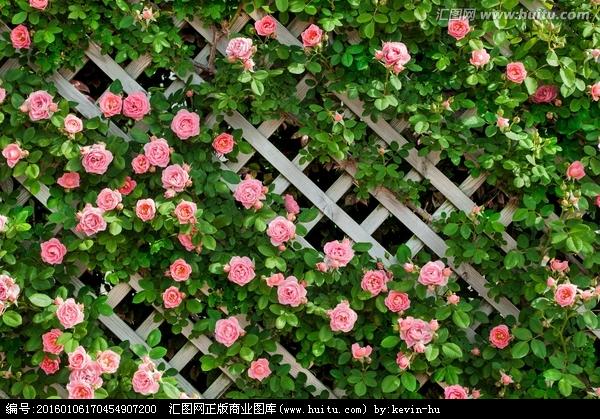
About soil:
Roses do not select soil, but whether they are planted or planted, they are best grown in sandy soil rich in humus.
About moisture:
Rose like run and afraid of wet avoid waterlogging, from germination to flowering, water can be more appropriate to pouring a little, but not for the degree of soil moist waterlogging, after watering flowers can not be too much to see the soil dry and wet, rainy season should pay attention to drainage.
About fertilizer:
It is also like fertilizer, barren, March can be 1 to 2 times with nitrogen based fertilizer, promote the growth of branches, April, May 2 times to 3 times the phosphorus and potassium based fertilizers, and promote its multi bud flowering, after flowering Zaishi a rejuvenation after fertilizer can no longer rose fertilization system positive flower, it is warm, cold, North and south, can overwinter safely outdoors.
About pruning:
The germination ability of the rose is vigorous and the growth is luxuriant. If it is not pruned in time, it is easy to produce diseases and insect pests under the condition of hot and humid, lack of light and poor ventilation. Therefore, a pruning should be carried out after the flower.
About plant diseases and insect pests:
In the rainy and humid, poor ventilation, poor sunshine conditions rose susceptible to powdery mildew, once discovered will cut the diseased branches destroyed, in order to avoid infection, and spraying low concentration of LSSS or Bordeaux, Topsin solution, to prevent the spread of the disease.

3
0
成长记
elvenking42
2017年06月09日

Repotted into a wide clay pot alongside the other two cuttings. Used a special cactus potting soil with them
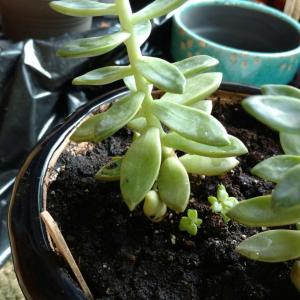
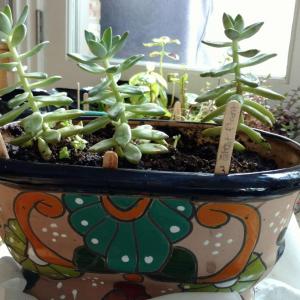


0
0
文章
安静的美女子
2017年05月23日

Before you toss another tea bag, must check out this post! Tea bags are not just for brewing tea, there are so many TEA BAG USES in the garden that can be useful.Tea leaves contain around 4.15 percent nitrogen and other nutritions that nourish the soil. Tea leaves also improve soil structure and increase the drainage. Also, the tannic acid in tea leaves can mildly change and lower your soil pH, just like used coffee grounds.
Also Read: Used Coffee Ground Uses In Garden
1. Composting

Probably the simplest use of used tea bags. Tea bags are great to add to compost because they add nitrogen to the compost and also attract good bacterias. But before you toss your used tea bags into the compost pile, make sure they are not made up of plastic. If they are of plastic, slit open the bag and use tea leaves for composting.
2. Repel Pests
If you are looking for an organic way to repel pests, your used tea bags can help you. Simply brew a weak tea with old bags and use it to water your plants and also sprinkle on leaves. It is really a great organic way to deter pests and fungal diseases and also provide plants some nutritions in doing so.
3. Plant Food

Make your plants lush and happy with used tea leaves. Just tear open some tea bags and disperse the contents around the plants. Tea leaves will nourish your plants every time you water by increasing nitrogen levels, improving soil structure and giving earthworms something delicious to eat.
4. Feed your Acid-Loving Houseplants
Ferns and many other houseplants prefer acidic soil. Fertilize your acid-loving houseplants with used tea bags. Open up the tea bags and work used tea leaves into the soil in their pots. It will slightly lower the pH level and also provide your plants with some nutritions and minerals.
5. Speed up Composting

Brew a strong tea with used tea bags and after it had cooled down, pour the liquid and tea bags over your compost heap. It will speed up the composting process as tea leaves contain nitrogen and also make your compost acid rich slightly.
6. Natural Fertilizer for Potted Plants
Just brew a weak tea with used tea bags and substitute watering with it. Brewed tea leaves make a fabulous liquid fertilizer as they contain high levels of minerals, carbohydrates, and other nutrients that help plants to grow.
7. Give Roses a Boost
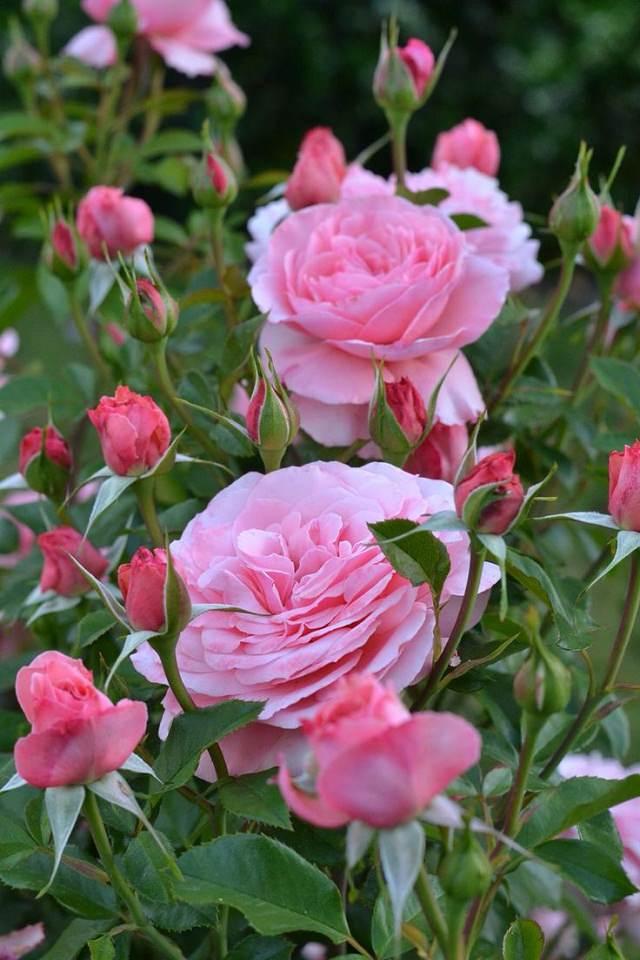
Roses love tea leaves. Slit open the used tea bags and sprinkle tea leaves around your roses to give them a boost.
Remember Roses love the tannic acid that occurs naturally in tea
Also Read: Used Coffee Ground Uses In Garden
1. Composting

Probably the simplest use of used tea bags. Tea bags are great to add to compost because they add nitrogen to the compost and also attract good bacterias. But before you toss your used tea bags into the compost pile, make sure they are not made up of plastic. If they are of plastic, slit open the bag and use tea leaves for composting.
2. Repel Pests
If you are looking for an organic way to repel pests, your used tea bags can help you. Simply brew a weak tea with old bags and use it to water your plants and also sprinkle on leaves. It is really a great organic way to deter pests and fungal diseases and also provide plants some nutritions in doing so.
3. Plant Food

Make your plants lush and happy with used tea leaves. Just tear open some tea bags and disperse the contents around the plants. Tea leaves will nourish your plants every time you water by increasing nitrogen levels, improving soil structure and giving earthworms something delicious to eat.
4. Feed your Acid-Loving Houseplants
Ferns and many other houseplants prefer acidic soil. Fertilize your acid-loving houseplants with used tea bags. Open up the tea bags and work used tea leaves into the soil in their pots. It will slightly lower the pH level and also provide your plants with some nutritions and minerals.
5. Speed up Composting

Brew a strong tea with used tea bags and after it had cooled down, pour the liquid and tea bags over your compost heap. It will speed up the composting process as tea leaves contain nitrogen and also make your compost acid rich slightly.
6. Natural Fertilizer for Potted Plants
Just brew a weak tea with used tea bags and substitute watering with it. Brewed tea leaves make a fabulous liquid fertilizer as they contain high levels of minerals, carbohydrates, and other nutrients that help plants to grow.
7. Give Roses a Boost

Roses love tea leaves. Slit open the used tea bags and sprinkle tea leaves around your roses to give them a boost.
Remember Roses love the tannic acid that occurs naturally in tea
2
1
文章
安静的美女子
2017年05月23日

Rubber tree plant care as a houseplant is easy. If you keep it in a well-lit position in your home. Besides the ornamental aspect, rubber tree is considered an air purifying plant.

Family: Moraceae
Soil pH: Neutral, slightly acidic
Plant type: Tree, Indoor plant
Vegetation type: Perennial
Foliage type: Evergreen
Toxicity: Its sap is toxic and causes mild skin irritation or burning sensation in eyes if comes contacted
Propagation: Rubber tree is commonly propagated from cuttings or air layering.
Popular Varieties– Ficus elastica ‘Tineke’ with variegated green and white leaves having overtones of burgundy and red veins.– Ficus elastica ‘Doescheri’: Also called “Indian Rubber Tree”, it has dark green foliage with yellow patches. Plant of this variety needs more natural light than most of the other variety.– Ficus elastica ‘Black Prince’: This variety has thick dark green leathery foliage with bronze undertones and large rounded leaves.-Ficus elastica ‘Decora’: This variety has thick dark green foliage.Rubber Tree Plant Information
Native to South-East Asia, the rubber tree grows on the edge of tropical rain forests. It can grow up to 30 m high in its native conditions. However, when you grow rubber tree indoors as a houseplant it only reaches 2-3 m high. *You can grow rubber tree outdoors in USDA Zones 9 – 11.
Rubber tree plant care is easy, which makes it a very popular houseplant. It survives even in poorly lit areas, though with slow growth.
Also Read: How to Grow Fiddle Leaf Fig
Rubber Tree Plant Care and Growing RequirementsLocation
Avoid direct sunlight, especially afternoon sun. Otherwise, the leaves will eventually fall off. Place the plant on a bright and well-lit spot that receives indirect or morning sunlight.
Soil
Use well-drained quality potting mix suitable for houseplants and a container with proper drainage. Rubber tree plant care will be easy if you fulfill only these two requirements.
Temperature
Ideally, the temperature that suits it best lies in a range of 59 – 68 F (15 to 20 C). It can withstand winter temperature down to 40 F (4 C), but the leaves may suffer.
Humidity
Rubber tree prefers moderately cool, moist and humid air. For humidity, you can mist water on its foliage.
Watering
Provide sufficient drainage to plant and avoid excess watering as it may cause root rot. Limit watering to keep the soil slightly moist and leave the surface soil to dry out between watering spells.
Fertilizer
Fertilize the plant with all-purpose fertilizer during the growing period in spring and summer.
Pests and Diseases
Rubber plant is resistant to pest and diseases. However, if grown in poor conditions and low light pests like spider mites and mealybugs cause a problem.
Pruning Rubber Tree
Pruning rubber tree is important if you want to keep it in a desired shape or size. You can prune the plant lightly at any time of the year but for proper pruning and trimming wait for spring. Prune your plant in the beginning of the growing season.
Rubber Tree Plant Care TipsRepot the plant when it becomes root bound. It grows quickly and within a year you’ll need to repot it.Once the desired size is achieved you can stop repotting and keep it root bound.If you’re unable to repot the plant, scrap a few inches of potting soil and replace it.When fertilizing indoor plants, ensure you don’t feed them heavily. Light dose is enough.Wipe and clean the leaves with a damp sponge once in a while.Avoid overwatering or misting of leaves with too cold water as rubber plant loses its leaves due to overwatering or when sprayed with too cold water.

Family: Moraceae
Soil pH: Neutral, slightly acidic
Plant type: Tree, Indoor plant
Vegetation type: Perennial
Foliage type: Evergreen
Toxicity: Its sap is toxic and causes mild skin irritation or burning sensation in eyes if comes contacted
Propagation: Rubber tree is commonly propagated from cuttings or air layering.
Popular Varieties– Ficus elastica ‘Tineke’ with variegated green and white leaves having overtones of burgundy and red veins.– Ficus elastica ‘Doescheri’: Also called “Indian Rubber Tree”, it has dark green foliage with yellow patches. Plant of this variety needs more natural light than most of the other variety.– Ficus elastica ‘Black Prince’: This variety has thick dark green leathery foliage with bronze undertones and large rounded leaves.-Ficus elastica ‘Decora’: This variety has thick dark green foliage.Rubber Tree Plant Information
Native to South-East Asia, the rubber tree grows on the edge of tropical rain forests. It can grow up to 30 m high in its native conditions. However, when you grow rubber tree indoors as a houseplant it only reaches 2-3 m high. *You can grow rubber tree outdoors in USDA Zones 9 – 11.
Rubber tree plant care is easy, which makes it a very popular houseplant. It survives even in poorly lit areas, though with slow growth.
Also Read: How to Grow Fiddle Leaf Fig
Rubber Tree Plant Care and Growing RequirementsLocation
Avoid direct sunlight, especially afternoon sun. Otherwise, the leaves will eventually fall off. Place the plant on a bright and well-lit spot that receives indirect or morning sunlight.
Soil
Use well-drained quality potting mix suitable for houseplants and a container with proper drainage. Rubber tree plant care will be easy if you fulfill only these two requirements.
Temperature
Ideally, the temperature that suits it best lies in a range of 59 – 68 F (15 to 20 C). It can withstand winter temperature down to 40 F (4 C), but the leaves may suffer.
Humidity
Rubber tree prefers moderately cool, moist and humid air. For humidity, you can mist water on its foliage.
Watering
Provide sufficient drainage to plant and avoid excess watering as it may cause root rot. Limit watering to keep the soil slightly moist and leave the surface soil to dry out between watering spells.
Fertilizer
Fertilize the plant with all-purpose fertilizer during the growing period in spring and summer.
Pests and Diseases
Rubber plant is resistant to pest and diseases. However, if grown in poor conditions and low light pests like spider mites and mealybugs cause a problem.
Pruning Rubber Tree
Pruning rubber tree is important if you want to keep it in a desired shape or size. You can prune the plant lightly at any time of the year but for proper pruning and trimming wait for spring. Prune your plant in the beginning of the growing season.
Rubber Tree Plant Care TipsRepot the plant when it becomes root bound. It grows quickly and within a year you’ll need to repot it.Once the desired size is achieved you can stop repotting and keep it root bound.If you’re unable to repot the plant, scrap a few inches of potting soil and replace it.When fertilizing indoor plants, ensure you don’t feed them heavily. Light dose is enough.Wipe and clean the leaves with a damp sponge once in a while.Avoid overwatering or misting of leaves with too cold water as rubber plant loses its leaves due to overwatering or when sprayed with too cold water.
0
0






